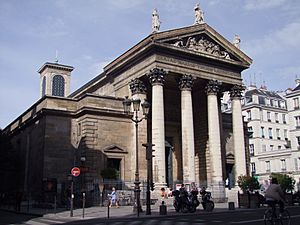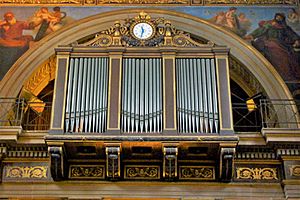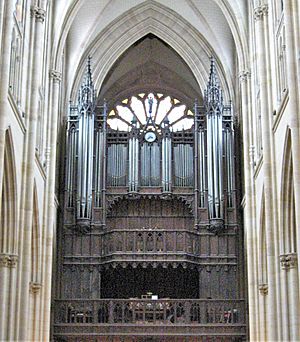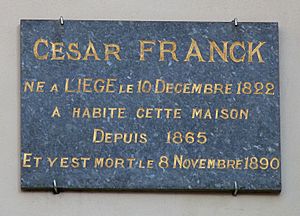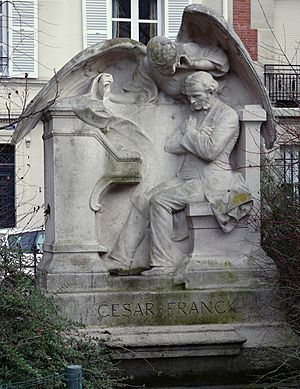César Franck facts for kids
César-Auguste Jean-Guillaume Hubert Franck (born December 10, 1822 – died November 8, 1890) was a French composer, pianist, organist, and music teacher. He was born in what is now Belgium. He is known for his beautiful Romantic music.
Franck was born in Liège, which was then part of the Netherlands. He gave his first concerts there in 1834. From 1835, he studied music privately in Paris. One of his teachers was Anton Reicha. After a short time back in Belgium, he moved to Paris for good. There, he got married and started his career as a teacher and organist. He became very good at improvising music, which means making it up on the spot. He also traveled around France to show off new organs built by Aristide Cavaillé-Coll.
In 1858, Franck became the main organist at the Basilica of St. Clotilde, Paris. He kept this job for the rest of his life. In 1872, he became a professor at the Paris Conservatoire. To get this job, he had to become a French citizen. After becoming a professor, Franck wrote many famous pieces. These included works for orchestra, chamber music (for small groups of instruments), and keyboard pieces for organ and piano. Many composers and musicians looked up to him as a teacher and composer. Some of his students included Ernest Chausson, Vincent d'Indy, and Louis Vierne.
Contents
Early Life and Studies (1822–1842)

César Franck was born in Liège. His father, Nicolas-Joseph Franck, was a bank clerk. His mother was Marie-Catherine-Barbe Franck. Young César-Auguste, as he was called, was good at both drawing and music. But his father wanted him to be a famous pianist and composer, like Franz Liszt. His father enrolled him at the Royal Conservatory of Liège. There, César-Auguste studied music theory (solfège), piano, organ, and harmony. He gave his first concerts in 1834, even playing for King Leopold I of Belgium.
In 1835, his father decided they needed a bigger audience. So, he brought César-Auguste and his younger brother Joseph to Paris. They studied privately with famous teachers. César-Auguste studied counterpoint with Anton Reicha and piano with Pierre Zimmerman. Both teachers also taught at the Paris Conservatoire. When Reicha died, his father wanted to enroll both boys in the Conservatoire. However, the Conservatoire did not accept foreign students. So, his father had to become a French citizen, which happened in 1837. During this time, his father promoted concerts in Paris. César-Auguste and his brother played popular music, and they usually got good reviews.
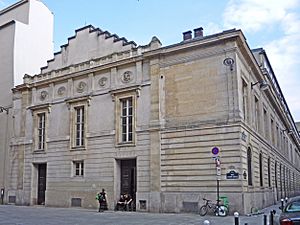
César-Auguste and his brother joined the Conservatoire in October 1837. César-Auguste continued his piano studies and started composition. He won first prize in piano in 1838. He also won prizes in counterpoint. He then added organ studies with François Benoist. He aimed to compete for a big composition prize, the Prix de Rome, in 1842. However, he left the Conservatoire on April 22, 1842.
His father might have made him leave. While César-Auguste was studying, he was also teaching privately and giving concerts. His father's strong promotion of his sons upset some music critics in Paris. Critics praised César-Auguste's piano skills but felt his compositions were not yet strong. This situation got worse because of a disagreement between his father and a main music critic. This might have led his father to decide they should return to Belgium in 1842.
Teacher and Organist (1842–1858)
The family's return to Belgium did not last long, less than two years. Concerts were not profitable, and critics were not impressed. So, his father brought him back to Paris. César-Auguste continued teaching and playing in family concerts. This was a tough time for him, with hard work and low pay.
However, this period was important for Franck's music. He wrote his first important works, a set of Trios for piano, violin, and cello. Franz Liszt saw them and encouraged him. In 1843, Franck started an oratorio (a large musical work for voices and orchestra) called Ruth. It was first performed privately in 1845 for important musicians like Liszt. They gave it some good feedback. But a public performance in 1846 was not successful. People were not interested, and critics found it too simple. The work was not performed again until 1872, after Franck changed it a lot.
After this, César-Auguste mostly stepped back from public life. He became a quiet teacher and accompanist. He wrote some pieces to celebrate the new French Second Republic in 1848. Some were popular, but they were forgotten when the Republic changed to the Second French Empire. He also tried writing an opera in 1851, but he later said it was "not worth printing." This quiet time helped him figure out what he wanted to do with his music. Two big changes during these years shaped the rest of his life.
The first change was a break from his parents, especially his father. This happened because of his friendship with one of his piano students, Eugénie-Félicité-Caroline Saillot. Her family's home became a safe place for him away from his demanding father. When his father found a music piece dedicated to Félicité, he tore it up. César-Auguste immediately rewrote it from memory and gave it to her. His father did not want him to marry Félicité. But as soon as César-Auguste turned 25 in 1847, he told his father he would marry her. They got married on February 22, 1848, during a time of revolution in Paris. To reach the church, they had to climb over street barricades. His parents did attend the wedding, showing they had somewhat accepted it. From then on, Franck signed his works as César Franck. He wanted to show he was making a fresh start.
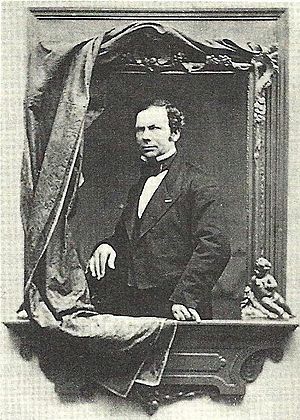
The second big change was his new job as assistant organist at Notre-Dame-de-Lorette, Paris in 1847. This was the first of several important organ jobs. He wanted an organist's job because it gave him a steady income. He learned the skills needed to play for church services. In 1853, he became the main organist at a new church, Saint-Jean-Saint-François-au-Marais. This church had a wonderful new organ built by Aristide Cavaillé-Coll. Franck loved this organ, saying, "My new organ, it's like an orchestra!" His skill at improvising music was in high demand. He also worked with Cavaillé-Coll to demonstrate new organs in towns across France.
At this time, French organ playing was changing. A German organist, Adolf Friedrich Hesse, showed new pedal techniques in Paris in 1844. This made it possible to play the complex works of Johann Sebastian Bach. This was very different from what Franck had learned. Then, Hesse's student, Jacques-Nicolas Lemmens, came to Paris in 1852 and 1854. Lemmens was a master of Bach's music and taught new methods for playing the organ with precision. Franck heard Lemmens play and was very impressed. He realized these new techniques could expand organ music. He worked hard to learn them.
Main Organist at Sainte-Clotilde (1858–1890)
Franck's journey to master new organ techniques continued with his most important organ job. On January 22, 1858, he became the organist at the new Sainte-Clotilde. He stayed there until his death. Eleven months later, the church installed a new, grand Cavaillé-Coll organ. This organ had a huge impact on Franck's playing and composing. It shaped his music for the rest of his life. Franck loved this organ, saying, "If you only knew how I love this instrument... it is so flexible under my fingers and so obedient to all my thoughts!" To practice, Franck bought a special pedalboard for his home. He also spent many hours at the church organ.
His reputation as an improviser and composer grew. He wrote pieces for organ, choir, and harmonium (a type of pump organ). One of his most famous pieces from this time is the communion song "Panis angelicus". Even more important are his Six Pièces for organ, written between 1860 and 1862. These pieces are still a key part of organ music today. They were the first major French organ works in over a century. They include two of his best-known organ pieces: "Prélude, Fugue et Variation" and the "Grande Pièce Symphonique".
Franck became very popular for playing at the opening of new Cavaillé-Coll organs. He played at famous churches like Saint-Sulpice, Notre-Dame, and La Trinité. At his own church, Sainte-Clotilde, many people came to hear his improvisations during Mass. Franck also started giving organ concerts of his own music and others'. In April 1866, Franz Liszt came to hear Franck play. Liszt was very impressed and later organized a concert to promote Franck's organ works. Franck also learned from hearing other great organists, like Anton Bruckner, in 1869. He began to have a regular group of students who were interested in his way of composing.
Franck continued to write choir music, but most of it was not published. He started working on a major choral piece called Les Béatitudes in 1869. This work took him more than ten years to finish, partly because of the Franco-Prussian War. The war caused many of his students to leave Paris or be hurt. Franck and his family faced financial difficulties. But after the war, French musicians wanted to create a unique French style of music. Franck became the oldest member of a new group called the Société Nationale de Musique. His music was played at their first concert in November 1871.
Professor and Composer (1872–1890)
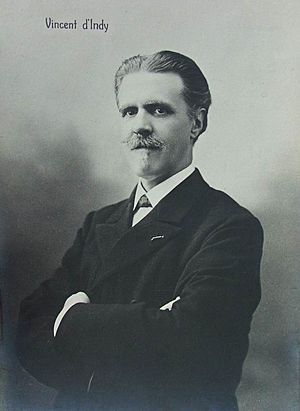
Franck's reputation grew, and when his old teacher Benoist retired from the Paris Conservatoire in 1872, Franck was chosen to take his place as organ professor. There was a small problem: Franck was not a French citizen, which was required for the job. He thought he was French because his father had become a citizen when César was a child. But he had unknowingly gone back to being Belgian when he turned 21. Franck quickly became a French citizen, and his appointment was made official in 1873.
Many of his students from his private lessons also studied at the Conservatoire. Some of his most famous students were Vincent d'Indy, Ernest Chausson, and Louis Vierne. This group of students became very close to their teacher. They all started calling him Père Franck, meaning "Father Franck." However, Franck faced some challenges at the Conservatoire. He often taught composition, not just organ. He also had his own teaching style, which was not always by the book. His popularity among students made some other professors jealous.
Now, Franck had more time to compose. He worked on Les Béatitudes and also wrote other pieces. These included the oratorio Rédemption (1871), the symphonic poem Les Éolides (1876), and the piano Quintet (1879). Les Béatitudes was finally performed in 1879. But like many of his larger works, it was not a big success at first. It was often performed in parts, not as a whole. Even his students felt it could be a bit "monotonous" at times.
In the 1880s, Franck felt pulled in different directions. His wife, Félicité, preferred his older style of music. But his students, who had a strong influence on him, encouraged him to try new things. One student said that Franck often asked his pupils for their opinions when he was composing. His wife sometimes said that his students caused people to be against him. There were also some disagreements within the Société Nationale, where Camille Saint-Saëns often disagreed with Franck and his students.
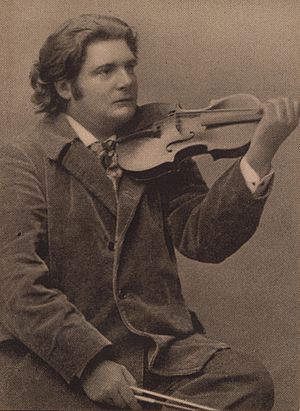
Despite these challenges, Franck wrote many "advanced" works during this time. These included the symphonic poems Le Chasseur maudit (1882) and Les Djinns (1883–1884). He also wrote the Symphonic Variations (1885) for piano and orchestra. Many of these works were not immediately successful. However, his Quintet of 1879 was seen as a powerful and interesting piece.
In 1886, Franck composed his famous Violin Sonata as a wedding gift for the Belgian violinist Eugène Ysaÿe. This piece was a huge success! Ysaÿe played it in Brussels, Paris, and on tour. It became Franck's most popular work and a favorite in chamber music.
Franck received the French Légion d'honneur award in 1885. His supporters felt this honor was long overdue. They were annoyed that the award was given to him simply as a "professor of organ" for his years of service, not for his amazing compositions. However, the public generally saw it as a well-deserved honor for a great composer.
Another discussion arose with his symphonic poem Psyché (1886–88). The debate was not about the music itself, but about the meaning of the story it told. Franck's wife and son found the work too emotional. They wanted him to write more popular and commercial music. But his student d'Indy saw a deep, spiritual meaning in it.
More debate came with Franck's only symphony, the Symphony in D minor (1888). The orchestra at the Conservatoire did not like it, and the audience was "ice-cold." Critics were confused, with reactions ranging from praise to strong dislike. Many other composers were also put off by its style. Franck himself said it was "just music, nothing but pure music." He later told his students he would not write like that again.
In 1888, Franck started another opera, Ghiselle, but he never finished it. In contrast, his large String Quartet was completed and performed in April 1890. It was very well received by both the public and critics. He also had other recent successes, including his own piano concerts. He continued to play his Sunday improvisations at Sainte-Clotilde. He planned to write more major works for organ and a cello sonata.
Illness and Death
In July 1890, Franck was in a horse-drawn trolley that was hit by another vehicle. He hit his head and fainted briefly. He thought it was not serious. However, walking became painful, and he had to miss concerts and lessons. He went on vacation to Nemours, hoping to work on his new organ pieces and other commissioned works. He managed to start both projects during his vacation.
While Franck could not finish all his harmonium pieces, the organ works were completed in August and September 1890. These are the Trois Chorals, which are considered some of the greatest organ music ever written. They are still played regularly today. Many people see them as his musical "last will and testament."
Franck started the new term at the Conservatoire in October. But he caught a cold, which turned into a serious lung and heart infection. His condition quickly worsened, and he died on November 8, 1890. While his death is often linked to the trolley accident, the infection itself could have been fatal for a man his age, especially without modern medicine.

Franck's funeral was held at Sainte-Clotilde. Many famous musicians attended, including Camille Saint-Saëns, Gabriel Fauré, and Charles-Marie Widor, who took over Franck's teaching job at the Conservatoire. Franck was later buried at Montparnasse Cemetery in Paris. His students commissioned a bronze bust of Franck by the famous sculptor Auguste Rodin, which was placed on his tomb. In 1904, a monument to Franck, César Franck at the Organ, was placed near Sainte-Clotilde.
Franck's Music
Many of Franck's works use "cyclic form". This means he connects different parts of a piece by using the same musical ideas or themes throughout. The main melodies are often related and appear again in the final part of the work. His Symphony in D minor is a great example of this.
His music often has complex layers of melodies, like a musical conversation (called counterpoint). His harmonies sound like late Romantic music, showing influences from composers like Franz Liszt and Richard Wagner. Franck was very good at changing keys smoothly and often. His students said he always told them to "modulate, modulate," meaning to change keys. This way of changing keys and shaping melodies is a key part of his unique style.
Franck had very large hands, which allowed him to play wide chords and stretches on the keyboard. This gave him special flexibility in his organ and piano music. For example, in his Violin Sonata, the piano part has many wide chords.
The key to understanding his music might be his personality. His friends described him as a humble, simple, and hardworking man. His student Louis Vierne said that Franck always cared about the importance of his art. He wanted his music to be sincere and noble. Whether joyful or sad, powerful or gentle, Franck's music at Sainte-Clotilde always had a deep feeling.
Legacy
It's interesting that even though César Franck was a very important composer, his fame mostly comes from a small number of pieces he wrote later in his life. These include his Symphony in D minor (1886–88), the Symphonic Variations for piano and orchestra (1885), and the Sonata for Violin and Piano in A major (1886). His Symphony was especially admired by younger French composers. It helped bring back the French tradition of writing symphonies after a period of decline. One of his best-known shorter works is "Panis angelicus", a beautiful song for choir and instruments.
As an organist, Franck was famous for his amazing skill at improvising. Many people consider him the greatest organ composer after Johann Sebastian Bach. His organ works were some of the best from France in over a century. They helped create the French "symphonic organ" style. His early Grande Pièce Symphonique paved the way for the organ symphonies of composers like Charles-Marie Widor and Louis Vierne. His later Trois Chorals are a cornerstone of organ music and are often played in concerts today.
Franck had a big influence on music. He helped bring new life to chamber music and developed the use of cyclic form. Later composers like Claude Debussy and Maurice Ravel used cyclic form in their own ways. Franck's role as an organist and composer is central to his place in French music history.
See also
 In Spanish: César Franck para niños
In Spanish: César Franck para niños



